The liberation of Novorossiysk and the Taman Peninsula. 3 part
The victory achieved by the Soviet troops at Novorossiysk, was crucial in the liberation of the Taman Peninsula. The advance of the troops of the 18 Army in the direction of Anapa and the landing of amphibious assault forces on the flanks of the German troops began to threaten the entire Taman group of the Wehrmacht.
Creating the “Blue Line”, the German command seriously hoped to retain the Taman bridgehead and most of Novorossiysk. This bridgehead was of strategic importance, covering the approaches to the Crimea from the side of the Kerch Strait. Owning the Taman coast, the Germans largely fettered the actions of the Soviet Black Sea fleet. Significant forces of the Red Army and Navy were riveted to the Taman bridgehead. For these reasons, the German high command delayed the evacuation of its troops from the peninsula. There was a Krimgild plan for the systematic evacuation of troops from the Taman Peninsula to the Crimea. However, the offensive of the Soviet troops forced the German command to change plans and begin the operation "Brünnhilde" - an accelerated evacuation of troops. Already on September 11, the chief of staff of Army Group A informed the chief of the operational department of the ground forces that it was unlikely that Russian troops could be driven out of Novorossiysk. The German command begins a hasty withdrawal of troops.
Commander Petrov, to speed up the liberation of Novorossiysk and prevent the enemy from withdrawing from the Taman Peninsula, on September 11 ordered the 9 and 56 armies to go on the offensive. On the morning of September 12, the 9 Army under the command of Grechkin struck in the direction of Keslerovo, Kalabatka, and Red October. The Germans occupied a strong position here on the heights. For four days the battle continued on the outskirts of Keslerovo. On September 16, units of the 389 Infantry Division, under the command of Colonel L. A. Kolobov, broke into the village. The German command was forced to enter into battle reserves, concentrated in the area of Kiev, Varenikovskoy, Gladkovskoy. This facilitated the offensive of the 18 Army in the area of Novorossiysk.
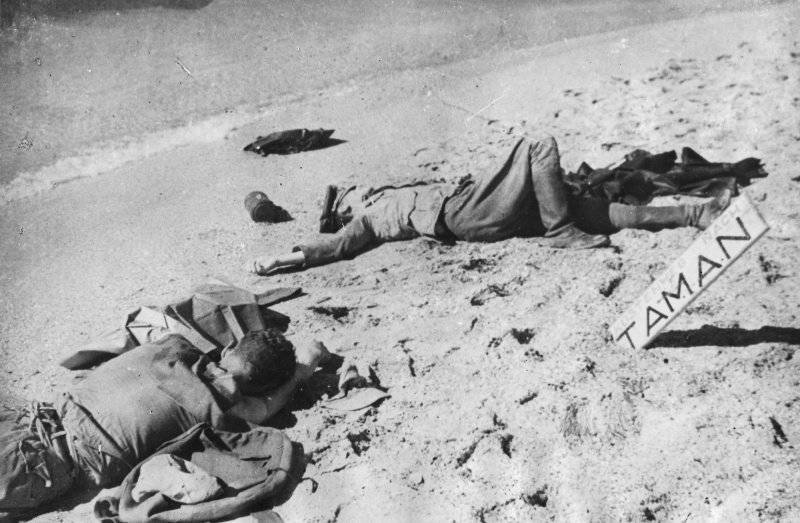
The German soldiers killed at the site of the fighting on the breakthrough of the Blue Line.
September 14 in 7 hours after 40-minute artillery preparation went on the offensive 56-I army under the command of Grechko. She delivered the main attack in the Kiev and Moldavan and Nizhnebakansky areas. During the first day, the army advanced just 800-1000 meters. This was due to the powerful defense of the enemy, there were almost continuous minefields, the Germans fired strong artillery and mortar fire and went into counterattacks. September 15 Grechko's army hardly progressed. On this day, the German command issued an order to begin the systematic withdrawal of the troops of the 17 Army of the right wing and center from the line of the Blue Line. The departure was covered by strong rearguards. At night, the 56-I Soviet army carried out a regrouping of forces and on September 16 broke through the central sector of the Blue Line. Soviet troops captured the main centers of resistance of the enemy - Kiev, Moldavan and Neberdzhayevskaya. By the end of the day, the Grechko army reached the Mill, Labor, Cool, Lower Greek and Amanat line.
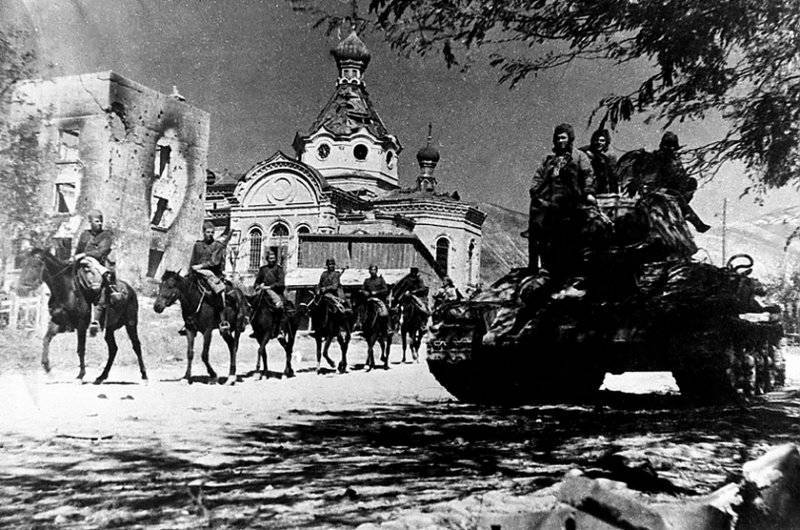
Soviet troops in the liberated Novorossiysk.
On September 17, German troops attempted to stabilize the situation and launched a strong counterattack in the Keslerovo area. They even managed to capture the village. However, they could no longer restore the position, since the Kievskoe was already occupied by units of the 56 Army. September 18 Germans again knocked out of Keslerovo. At the same time, the Germans for three days repelled the attacks of the Soviet troops, relying on the second defensive line. 9-I army was able to seize a bridgehead on the left bank of the river Adagum, but did not achieve success at the turn of the river. Kurka - on the direction of the main attack. At the same time, units of the 18 Army advanced 15-16 km and freed Haiduk, Vladimirovka, Glebovka, Yuzhnaya Ozereyka, and the Abrau-Durso state farm.
The German command, having lost Novorossiysk and lost support in the center, accelerated the withdrawal of troops. At intermediate positions, reinforced rear guards put up strong resistance. The actions of the German troops contributed to the terrain. Between the numerous estuaries and lakes there were strong natural frontiers, where the Germans destroyed the routes of communication and mined the approaches. Here, small forces could restrain the advance of a more numerous adversary. Soviet troops were forced to take each such frontier in combat, while the main forces of the enemy retreated. A large role in such a war was played by engineering units. The sappers cleared the area, found the mine traps of the enemy.
On September 19, units of the 56 Army liberated several settlements. On this day, stubborn battles took place on the outskirts of the village of Varenikovskaya, where the 22 th infantry corps of Major General V.F. Sergatskov was advancing. The Germans tried to halt the Soviet offensive in order to ensure the withdrawal of forces from the 9, 79 and 98 infantry and 97 light infantry divisions. Varenikovskaya was well fortified, covered with wire barriers, continuous minefields. At heights to the south of Varenikovskaya and in the forest on the west bank of the river, the enemy concentrated a significant amount of fire weapons. The defensive system included small water obstacles on the approaches to the village. The Germans concentrated significant forces on both sides of the highway passing through the village.
The Germans fought off the attack of the 22 th rifle corps from the front. The corps regrouped to bypass the village from the south. The scouts revealed the leading edge and the location of the fire weapons, the sappers made passages in the minefields and enemy obstacles. In the 24 hours of September 21, after an hour-long artillery preparation, the 22 corps went on the offensive. Part of the 351 Infantry Division under the command of Colonel A.V. Vorozhischev inflicted a flank attack, overcame water obstacles off the highway and on the shoulders of the enemy broke into Varenikovskaya. The Germans went to the counter, trying to dismember the battle formations of our troops. But the counterattacking German group was swept from the flanks and destroyed. By morning the village was completely freed. The Germans lost about 800 people, a lot of technology and weapons.
At the same time, the strike force of the 9 Army, consisting of units of the 316, 304 and 276 rifle divisions, launched an offensive. On the night of September 19, Soviet troops, along the assault bridges that the sappers had previously propelled, and in some places were swimming, forced the river Ibn. Kurka and on the move broke through the German defense. By the end of the day, Kalabatka strongholds, Red October and Grechkin’s army reached the village of Kurchanskaya. The next day, the Soviet soldiers liberated the village of Kurchanskaya.
In the 18th Army's offensive zone, especially stubborn battles were fought on the distant approaches to Anapa. This port was the naval base of the Taman group, connecting it with the Crimea. Here the Germans covered themselves with minefields, the mining density reached 2,5 thousand minutes per 1 km. Particularly fiercely, German troops fought for the mountainous areas near the village of Verkhnebakanskaya and at the Volch'i Vorota Pass. The Volch'i Vorota pass was of great operational importance, since most of the mountain roads crossed here. The Germans reinforced natural obstacles with artificial barriers. However, with the help of powerful aviation and artillery strikes, the Soviet troops also overcame this strong defensive line. Formations of the 5th Guards tank brigades with a quick blow liberated the village of Raevskaya, opening a direct path to Anapa. The sappers made passages in the minefields and established their borders, so the tank crews, almost without stopping, went to Anapa on September 21 and burst into the city on the move. At the same time, ships of the Black Sea Fleet raided the port of Anapa, destroying a number of enemy fortifications. With the onset of darkness, Soviet ships again broke into the port, fired at the firing points of the enemy and landed troops. Tankers and marines almost simultaneously broke into Anapa. This blow was so sudden that the Germans could not provide long-term resistance. On September 21, Soviet troops liberated Anapa and captured significant trophies, including 40 warehouses with military equipment, 41 guns, 77 mortars, etc.
Army Grechkin 24 September went to the village Gostagaevskaya. The 242 units of the mountain rifle division under the command of Colonel V. B. Lisinov defeated the German garrison, destroying the enemy battalion. Army forces with their left flank reached the Vityazevsky estuary. The Germans continued to resist stubbornly. But they did not have time to take out military property. I had to throw warehouses with ammunition, food, blow up guns, throw equipment and weapons. The chief of staff of the German 17-th army said in a bid that the army would have to destroy 40 thousand tons of military property. Panic moods spread among the part of the Romanian-German troops, the soldiers were afraid that there would be a “second Stalingrad”. 56-I army threw the enemy over the river. The old Kuban reached the next German defensive line, which passed between the Akhtanizovsky, Starotitarovsky and Kiziltash estuaries. Here the German defensive line should have been taken with frontal strikes.
At this time, the army Leselidze went to the village of Blagoveshchensk. Here the 89-Infantry Division and the 55-I Guards Irkutsk Division led the offensive. Simultaneously with the frontal attack, it was decided to land two landing forces: 1) tactical landing in the area of Blagoveshchensk; 2) main landing in the area of the Salty Lake to capture Taman. The entire landing force consisted of more than 8 thousand people. To accomplish the task, the fleet selected more than 60 ships, boats and bots. Due to the stormy weather, the landing was delayed. The first were able to land a tactical assault force in the area west of Blagoveshchensk - it included the 166 th Guards Regiment of the 55 th Guards Rifle Division and the 143 th battalion of marines. In total, more 25 people landed on the evening of September 800. The patrol boats supported the landing of troops with their fire. On the night of September 26, the main landing force of the 83 th naval rifle brigade was landed near the Salt Lake. The sailors fought all day in the area of the Salt Lake Battle, but could not penetrate the enemy defenses. Then the front command transferred additional forces to the area. We began the transfer of 103 and 8 of the Guards Rifle Brigades. September 27 Soviet troops developed an offensive in the direction of Taman. At this point, the auxiliary force, in cooperation with the units of the 55 Guards Division and the 5 Guards Tank Brigade, liberated the village of Blagoveshchenskaya.
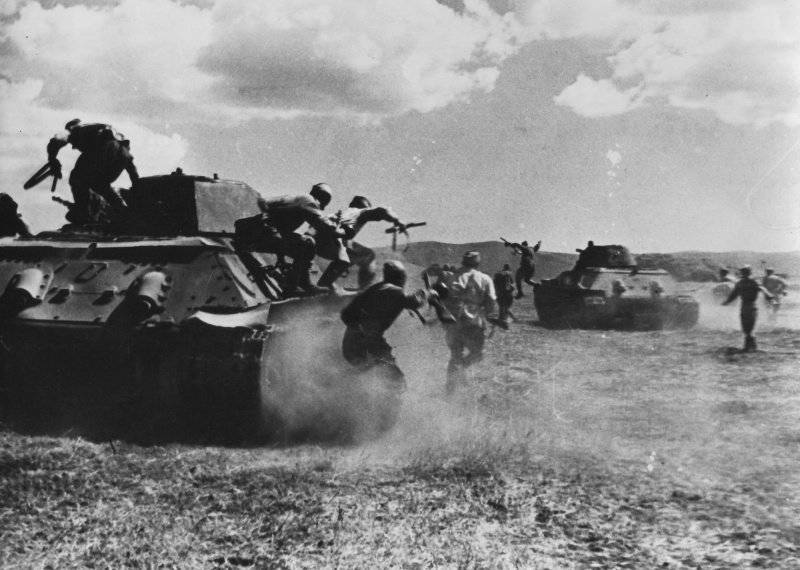
2-I Guards Rifle Division is to storm the German fortifications "Blue Line" on the Taman Peninsula.
Parts of the 9 Army conducted an offensive along the Kurchan estuary on Temryuk. Temryuk was a powerful knot of resistance and brought up the left flank of the Blue Line. In addition, Temryuk was an important communications hub. The approach to it from the east and south was covered by estuaries and fluids. The Germans reinforced the natural obstacles with wire barriers and minefields. The terrain hampered the use of large masses of troops using heavy weapons and equipment. Therefore, as part of the 9 Army, small special units were formed that had independent missions. September 26 Grechkin's army came to Temryuk. In order to speed up the fall of Temryuk, it was decided to land troops in two places: the main one - in the area east of Golubitskaya, and the auxiliary - in the Chaikino area. For the landing assault attracted about 45 ships and vessels.
September 25 began the landing of the main assault - it included the 545 th Infantry Regiment of the 389 Infantry Division. The paratroopers broke through the coastal defenses of the enemy, occupied the northeastern part of Golubitskaya, and cut the road Temryuk-Peresyp. The Germans launched strong counterattacks from the Peresyp area. The paratroopers occupied the perimeter defense east of Golubitskaya and for several days repelled the attacks of the enemy, preventing the Germans from retreating from Temryuk. Auxiliary landing - the 369-th separate battalion of marines entered it, also acted successfully. The marines landed in the Chaikino area and, despite significant losses, assisted in the capture of Temryuk. On the night of September 27, units of the 11 Infantry Corps after powerful aviation and artillery preparation broke into the eastern outskirts of the city. At the same time, part of the forces on the boats forced the Kurchansky estuary and attacked the enemy from the west. The Germans suffered heavy losses and retreated to Golubitskaya. But having met Soviet paratroopers, they had to flee to the village of Starotitarovskaya. By the morning of September 27, Temryuk was completely released.
An important role in the release of Temryuk and the landing operation was played by aviation, which effectively supported Soviet troops from the air. In addition, the aircraft prevented the evacuation of the enemy. The planes struck blows at the enemy’s accumulations of forces on the roads, in places of loading on ships and during the ferry to the Crimea. On these days, the 4 aircraft of the air army made up to 1800 sorties, sank about 150 enemy ships, and about 60 were badly damaged. Aviation of the Black Sea Fleet was also effective. From 20 to 28, September, Black Sea Fleet aviation planes shot down 56 German planes, sank near 60 ships.
The German command, trying to gain time, tried by all means to delay the Soviet offensive. Using a significant reduction in the front, the Germans were able to leave for defense at the turn of Golubitskaya, Red Arrow, Starotitarovskaya, large forces - 370-th, 79-th and 98-th infantry divisions. And the 50-I German infantry, the 19-I Romanian infantry and the 4-I mountain division, occupied the defensive line Akhtanizovskaya, Vyshestebliyevskaya, Veselovka. The Germans, not being able to evacuate ammunition depots, fired wildly with all types of weapons.
October 2 The 56-I army broke through the German defense between the Akhtanizovsky and Kiziltash estuaries and came out to Starotitarovsky. The Germans fiercely counterattacked, trying to restore the situation with the support of armored vehicles and powerful artillery and mortar fire. However, the Soviet infantry, with the support of the ACS, repulsed enemy counterattacks. Army Grechko seized Starotitarovskoy. Having broken through the German defenses, the Soviet troops captured the Vyshestebliyevskaya stanitsa and turned north, striking the rear of the German troops, who were holding back the attack of the 9 Army. The Germans hastily left Akhtanizovskaya and retreated to Kuchugurs, where they held another auxiliary line of defense. After that, the Soviet command ordered the 9 Army to be withdrawn to the front reserve.
At the same time, the troops of the 18 Army drove the enemy along the southern shore of the Taman Peninsula. Were released Veselovka, Taman. The troops of the 56 Army overnight stormed the last German defensive line near the village of Sennaya. October 8 turned violent battles for the capture of the last strongholds of the German troops - Kuchugury, Fontalovskaya and Tatar. 56-I army cut the German grouping, leaving west Kuchugur and Zaporozhskaya, in the flank and rear of the enemy. The Germans in a panic began to retreat to the Chushka Spit. By dawn 9 October, Soviet troops broke through the German positions on the outskirts of the spit, and went to the Kerch Strait. German troops who did not have time to evacuate were destroyed.
The operation was completed. On October 9, in Moscow hours 22 saluted the gallant troops of the North Caucasus Front and fleet formations that liberated the Taman Peninsula, 20 artillery volleys from 224 guns. Many units and formations of the front and the Black Sea Fleet received the honorary titles of Novorossiysk, Anapa, Kuban and Temryuk for their exploits.
Results
In the course of the Novorossiysk-Taman offensive, the forces of the North Caucasus Front defeated the Taman enemy grouping, eliminated the German bridgehead in the Kuban, from which the enemy could develop offensive actions towards the Caucasus. Soviet troops liberated Novorossiysk - an important naval base of the Black Sea Fleet. With the liberation of the Taman coast, the Black Sea Fleet was able to more effectively act on the sea communications of the Crimean enemy grouping. Favorable circumstances were created for the future liberation of the Crimean peninsula.
In the course of this operation, the Soviet soldiers broke through the powerful "Blue Line", fought over 150 km, defeated 8 German and 4 Romanian divisions. The Germans lost more than 36 thousand people killed, about 22 thousand wounded, 4 thousand prisoners, not counting the drowned and destroyed at the ferries. Soviet troops captured the 32 tank, more 550 guns and mortars and other weapons, equipment, a large amount of equipment, food.
We must not forget about the selfless actions of the Soviet partisans. During the Novorossiisk-Taman operation guerrillas spent about 500 combat and sabotage operations, more than 300 intelligence operations, destroyed up to 100 bridges and crossings in the rear of the enemy, smashed 15 staffs, 27 garrisons enemy 15 police force, made more than 100 raids on the rear of the column.
It should be noted that this was one of the most well-planned and prepared operations. During the liberation of Novorossiysk, the Soviet armed forces were able to conduct a well-organized and defiantly conducted landing of an amphibious assault force directly in Tsemesskaya (Novorossiysk) Bay. Despite the heavy losses that almost always accompany such operations, units of the 18 Army and the Black Sea Fleet successfully completed the task. Russian military chronicle replenished with another heroic feat. The liberation of Novorossiysk destroyed the entire system of German defense on the Taman bridgehead. At the same time, the Germans were able to withdraw most of their forces under the cover of the rear guards. After the breakthrough of the Blue Line, it was not possible to surround and destroy most of the enemy forces, the offensive resulted in the pursuit of an organized enemy. The German command successfully evacuated the defeated units of the 17 Army through the Kerch Strait on ships and aircraft. This was due to errors of command, intelligence, and the complexity of the terrain.
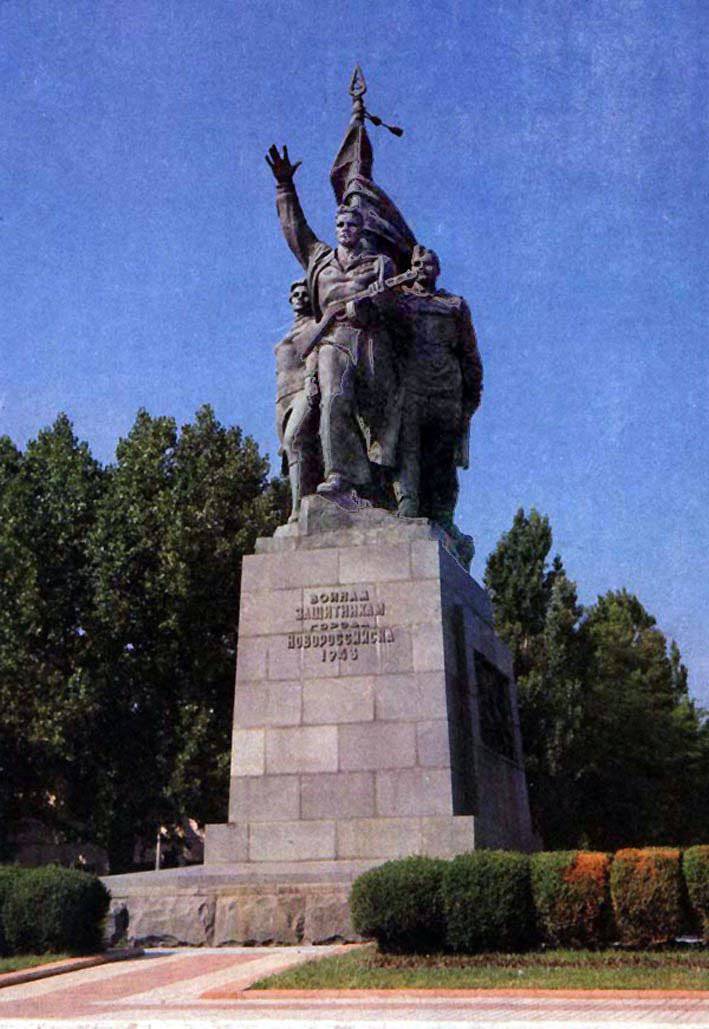
Monument "To soldiers - defenders of the city of Novorossiysk". Sculptors I.P. Shmagun and N. Timoshin. Architects K.M. Mikhailov and E.G. Lashuk. Opened in 1961
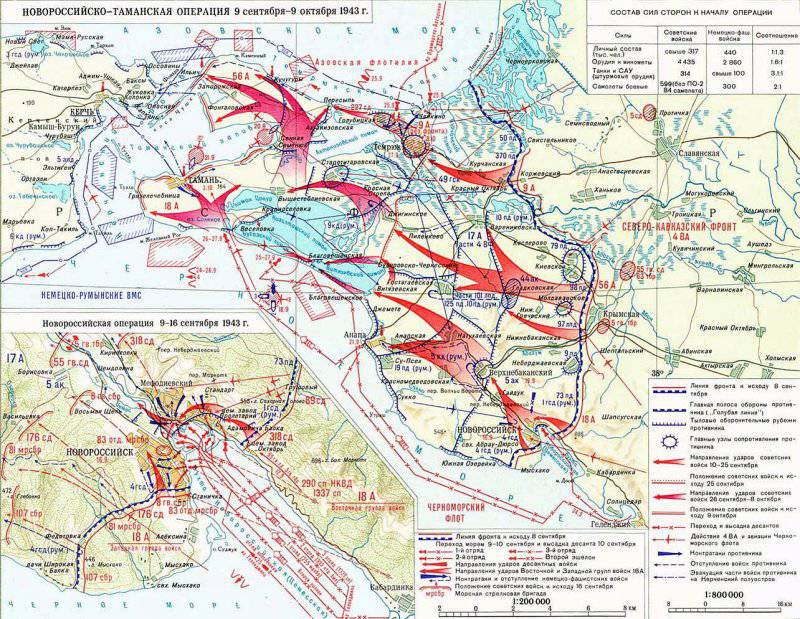
Information